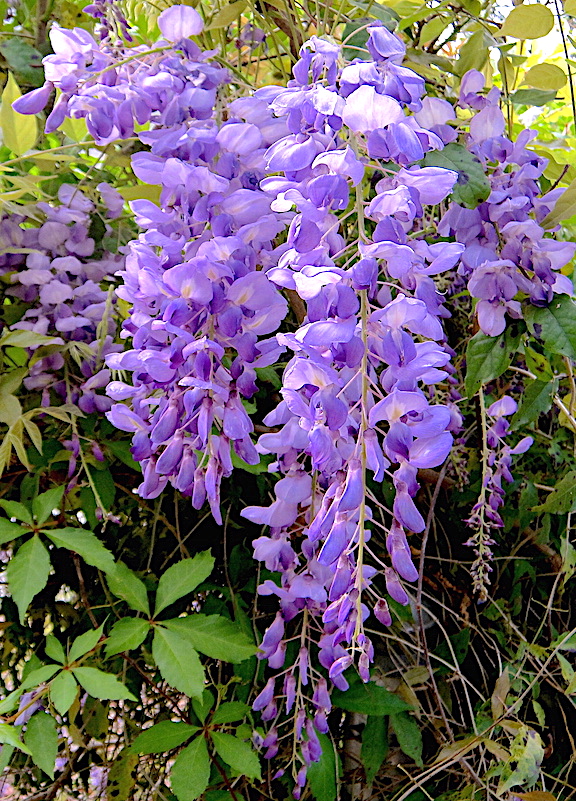
Wisteria is usually invasive though there is a native species. Photo by Green Deane
The weather may be chilly still it’s a hot time of year for foraging. A species blossoming now and rarely covered is Wisteria. I failed to notice it during our foraging class in Gainesville Sunday. (I only spotted it near the entrance after class.) The blossoms are edible raw or cooked but the rest of the plant is toxic (though that varies from species to species.) With some two seeds can kill a child. While most Wisteria is considered Asian there is a native species in the Americas, W. frutescens. You can read about Wisteria here.
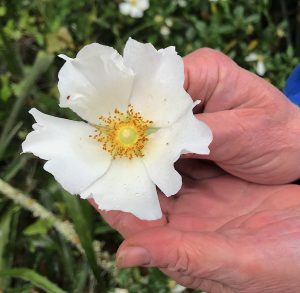
The non-aromatic Cherokee Rose is not native. Photo by Green Deane
Another Asian species sighted this weekend is one that was once considered native, the Cherokee Rose, which is actually an invasive. Botanically Rosa laevigata (Rosa is from the Greek ῥόδον (rhódon) meaning rose and laevitata or (Levis) is Dead Latin for smooth or polished. It’s a “climbing shrub” as is Smilax and Nicker Bean. Cherokee Rose is a large nearly odorless white bloomer from the low mountains of China and Vietnam. It was carried to the Americas in 1780 and was reportedly cultivated by the Cherokee thus the name. In 1916 at the urging of womens’ clubs it was made the state flower of Georgia and still is. It produces huge rose hips to two-inches long though you have to burn bristles off to use them. And as one might presume the rugged vining shrub is covered with mean prickles. Handle carefully. Sugar from the plant has been used to make wine.
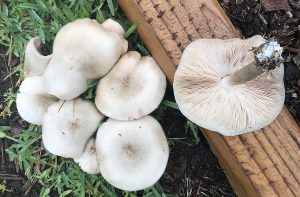
“Deer Mushrooms” are edible. Photo by Green Deane
An edible mushroom taking advantage of the cool, rainy weather is the Deer Mushroom, in this case Pluteus petasatus. These are bunching mushrooms usually growing on old hardwood remains, either logs, stumps, roots or debris. As often is the case the botanical name is more confusing than enlightening. Pluteus can mean shed or penthouse. Petasatus is Dead Latin for wearing a cap (meaning) ready for a journey. A relative is called P. cervinus the latter means deer or stag because of that species’ cap color. It is also sometimes called the Deer Mushroom or Fawn Mushroom. These two are edible but are viewed as marginal. One reason is the cap is mostly gills with little cap material. Sometimes it can have a radish flavor. Spore print is salmon to pink.

Classes are held rain or shine or cold. (Hurricanes are an exception.) Photo by Kelly Fagan.
Foraging Classes: We should have good weather for classes this weekend. Maybe I’ll ride my motorcycle if the nights are not too cold.
Saturday, March 27th, Eagle Park Lake, 1800 Keene Road, Largo, FL 33771. 9 a.m. to noon. Meet at the pavilion near the dog park.
Sunday, March 28th, Mead Garden: 1500 S. Denning Dr., Winter Park, FL 32789. 9 a.m. to noon. The entrance is on the west side of the park off Denning. (If you are going to attend this class please email me first.)
Saturday, April 3rd, Florida State College, south campus, 11901 Beach Blvd., Jacksonville, 32246. 9 a.m. to noon. We meet at Building A next to the administration parking lot. Whether the bathrooms are open or not is always a problem at this location. Because of that this class might be relocated to Palatka. This will be cleared up soon.
Sunday, April 4th, Bayshore Park, Bayshore Drive. Port Charlotte. Meet at the parking lot at Bayshore Drive and Ganyard Stree. 9 a.m. to noon.
For more information, to sign up or prepay, go here.
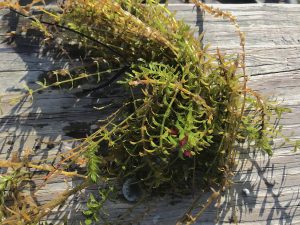
Hydrilla is used as a supplement. Photo by Green Deane
During a class in Ft. Pierce I managed to get a photo of Hydrilla for my forthcoming book ( schedule to be published next year.) I thought I had seen it in the lake before so I raked some out last Saturday. Invasive Hydrilla is a bit of a contradiction. A native of Europe there is no record of people using it. Yet it is grown, dried, powdered in Florida and sold as a calcium supplement. Ten grams has some 225 mg of calcium. So not edible but consumable. You can read about Hydrilla here.
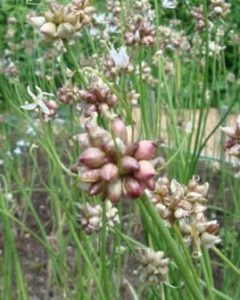
Wild Garlic will be cloving soon. Photo by Green Deane
Edible now is our wild garlic. It’s not at the stage of putting cloves on top yet but we sampled several leaves of it this past weekend. We’ll see it in Eagle Lake Saturday. Green right now are Mulberries and Blackberries. They should be ripe a month from now. We also saw flowering Hawthorn and Bradford Pears. Some plums are fruiting already. Going out of season is chickweed. It’s getting long, mature and bunchy.

Green Deane videos are now available on a USB.
150-video USB would be a good spring present and is now $99. My nine-DVD set of 135 videos is being phased out. In fact I do not have any. The USB videos are the same videos I have on You Tube for free. Some people like to have their own copy. The USB videos have to be copied to your computer to play. If you want to order the USB make a $99 “donation” using the link at the bottom of this page or here. That form provides me with your address, the amount — $99 — which tells me it is not a donation. Please include a snail-mail address because they are sometimes not included.

Green Deane Forum
Want to identify a plant? Perhaps you’re looking for a foraging reference? You might have a UFO, an Unidentified Flowering Object, you want identified. On the Green Deane Forum we — including Green Deane and others from around the world — chat about foraging all year. And it’s not just about warm-weather plants or just North American flora. Many nations share common weeds so there’s a lot to talk. There’s also more than weeds. The reference section has information for foraging around the world. There are also articles on food preservation, and forgotten skills from making bows to fermenting food.
This is weekly newsletter #450 If you want to subscribe to this free newsletter you can find the sign-up form in the menu at the top of the page.
To donate to the Green Deane Newsletter click here.

